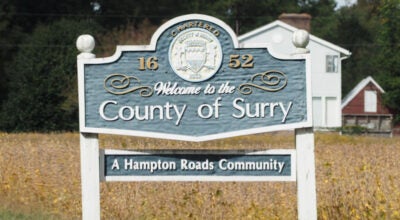Developer looks to revive stalled St. Luke’s Village
Published 1:26 pm Wednesday, December 6, 2023

- Greenwood Homes has submitted a revised plan for the long-stalled St. Luke’s Village development, which was originally approved in 2005. (Image courtesy of Brandon Currence Architects and Isle of Wight County)
A planned housing development in Carrollton that’s been dormant for 18 years may be revived under new ownership.
Kent Henry, director of land development for Charlottesville-headquartered Greenwood Homes, confirmed in a Dec. 4 email to The Smithfield Times that his company is under contract to purchase the roughly 60-acre St. Luke’s Village subdivision in 2024.
On Nov. 27, Isle of Wight County’s Director of Community Development Amy Ring provided the Times with a revised site plan Brandon Currence Architects had submitted in July showing 315 homes, up from the approved 179.
St. Luke’s original developer, Lewis McMurran of McCale Development, received rezoning approval from Isle of Wight’s Board of Supervisors in 2005. At the time, McMurran proposed building 430 homes and up to 80,000 square feet of commercial space on the former Smithfield Downs golf course, which shuttered in early 2006.
The land is located less than a quarter mile from the development’s 17th century namesake, St. Luke’s Church, which now operates as a museum.
By 2007, foreclosures on high-risk or “subprime” mortgages had begun to spur a nationwide housing market crisis. In 2008, the supervisors approved Sentara Health Systems’ application to build the Sentara St. Luke’s medical center in lieu of 176 houses, reducing the stalled development’s density to 254 homes.
In early 2014, the supervisors approved another requested change by McMurran further reduce St. Luke’s density to the current 179 approved residences, which at that time were proposed to consist of 135 single-family homes, 44 townhouses and just under 80,000 square feet of commercial space.
Greenwood’s plans show roughly the same street layout McMurran had originally proposed but call for higher-density housing consisting of 42 single-family homes, 140 duplexes 83 townhouses and a future residential phase with another 50 homes. Greenwood’s proposed commercial phase now calls for up to 99,221 square feet.
“Recognizing that the existing plans are over a decade old and have become outdated, we are dedicated to modernizing residential unit types and the overall unit mix to align with the evolving needs of today’s homebuyers,” Henry told the Times. “With this shift, we aim to contribute to a more affordable housing landscape by introducing additional density and diverse housing types, ultimately elevating the overall sense of place and livability.”
Greenwood’s plans call for access to the development from Brewers Neck Boulevard via a new four-lane road dubbed “St. Luke’s Boulevard.” St. Luke’s Boulevard would connect to an extension of King James Court to provide secondary access via the existing Queen Anne’s Court subdivision. A roundabout would facilitate traffic movement between St. Luke’s residential and commercial phases.
According to Ring, the county’s Planning Commission and supervisors will each be required to hold a public hearing on Greenwood’s revised plans due to the proposed change in density. The supervisors would then need to vote to approve Greenwood’s plans before construction can begin.
A population study Ohio-based Cooperative Strategies completed this spring for Isle of Wight County Schools estimated 62 new students would result from St. Luke’s under McMurran’s 179-home plan. The study projects more than 1,000 students will enter the county’s school system, potentially putting four of its nine schools over capacity, upon the buildout of 13 proposed and in-progress developments.
St. Luke’s is Greenwood’s second proposed expansion into Isle of Wight. The company previously submitted plans to the town of Smithfield’s zoning office in August for “The Promontory,” which would add 262 homes and five commercial parcels along the Benns Church Boulevard Corridor at the site of a 133-acre sand mining operation or “borrow pit.” The Promontory too, which would be located just inside the town’s limits, has yet to go before Smithfield’s Planning Commission or Town Council.





